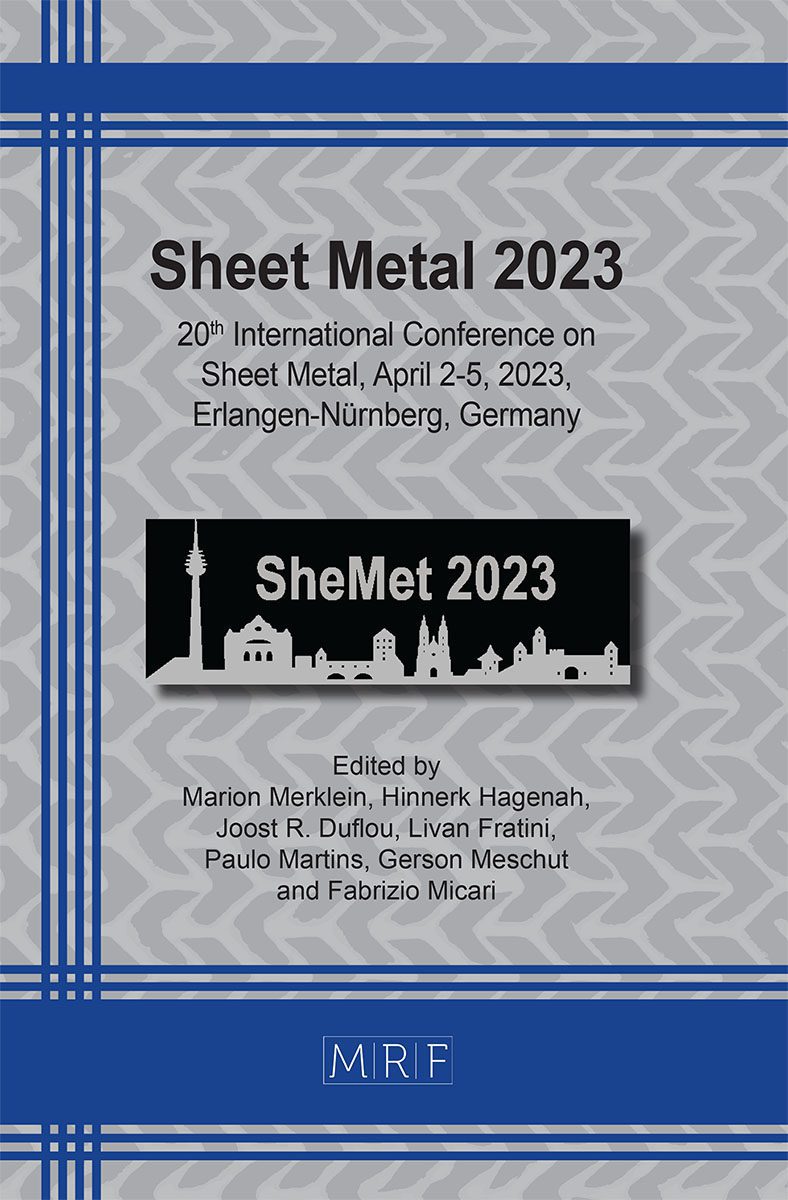Experimental investigation on thinning and forming force acting on multi-stage single point incremental forming
Nikhil Bari, Shailendra Kumar
download PDFAbstract. This paper describes a study of thinning and forming force in multi-stage single point incremental forming. Four process parameters namely pitch, tool diameter, blank thickness and initial draw angle are considered to study their influence on maximum thinning and peak forming force. Experiments are designed using face-centered composite design (CCD). Experimental results are analyzed using analysis of variance (ANOVA). It is found that initial draw angle is the most influencing parameter for maximum thinning, while peak forming force is most influenced by blank thickness. Maximum thinning decreases with decrease in initial draw angle and increase in blank thickness. Peak forming force decreases with decrease in blank thickness. Moreover, predictive models are developed for maximum thinning and peak forming force. Also, optimization of parameters is carried out to minimize thinning and forming force. The confirmation tests are performed to validate predictive model and optimization results.
Keywords
Incremental Sheet Forming, Predictive Models, Optimization
Published online 3/17/2023, 8 pages
Copyright © 2023 by the author(s)
Published under license by Materials Research Forum LLC., Millersville PA, USA
Citation: Nikhil Bari, Shailendra Kumar, Experimental investigation on thinning and forming force acting on multi-stage single point incremental forming, Materials Research Proceedings, Vol. 25, pp 53-60, 2023
DOI: https://doi.org/10.21741/9781644902417-7
The article was published as article 7 of the book Sheet Metal 2023
![]() Content from this work may be used under the terms of the Creative Commons Attribution 3.0 licence. Any further distribution of this work must maintain attribution to the author(s) and the title of the work, journal citation and DOI.
Content from this work may be used under the terms of the Creative Commons Attribution 3.0 licence. Any further distribution of this work must maintain attribution to the author(s) and the title of the work, journal citation and DOI.
References
[1] M. J. Mirnia, M. Vahdani, M. Shamsari, Ductile damage and deformation mechanics in multistage single point incremental forming, Int. J. Mech. Sci. 136 (2018) 396–412. https://doi.org/10.1016/j.ijmecsci.2017.12.051
[2] J. R. Duflou, A. K. Behera, H. Vanhove, L. S. Bertol, Manufacture of accurate titanium cranio-facial implants with high forming angle using single point incremental forming, Key Eng. Mater. 549 (2013) 223–230. https://doi.org/10.4028/www.scientific.net/KEM.549.223
[3] H. Choi, C. Lee, A mathematical model to predict thickness distribution and formability of incremental forming combined with stretch forming, Robot, Comput. Integr. Manuf. 55 (2017) 164–172. https://doi.org/10.1016/j.rcim.2018.07.014
[4] N. Bari, S. Kumar, Multi-stage Single-Point Incremental Forming: An Experimental Investigation of Surface Roughness and Forming Time, J. Mater. Eng. Perform. 24 (2022). https://doi.org/10.1007/s11665-022-07183-8
[5] H. K. Nirala, A. Agrawal, Sheet Thinning Prediction and Calculation in Incremental Sheet Forming. Springer Singapore, 2018. https://doi.org/10.1007/978-981-10-8767-7_15
[6] A. Gheysarian, M. Honarpisheh, Process Parameters Optimization of the Explosive-Welded Al/Cu Bimetal in the Incremental Sheet Metal Forming Process, Iran. J. Sci. Technol. – Trans. Mech. Eng., 43 (2019) 945–956. https://doi.org/10.1007/s40997-018-0205-6
[7] Z. G. An, D. Yan, J. J. Qie, Z. L. Lu, Z. Y. Gao, Effect of Process Parameters on Formability of a AZ31 Magnesium Alloy Thin-Walled Cylindrical Part Formed by Multistage Warm Single-Point Incremental Forming, Front. Mater. 7 (2020) 1–15. https://doi.org/10.3389/fmats.2020.00151
[8] S. Ghafoor, Y. Li, G. Zhao, J. Li, I. Ullah, F. Li, Deformation characteristics and formability enhancement during ultrasonic-assisted multi-stage incremental sheet forming, J. Mater. Res. Technol., 18 (2022) 1038–1054. https://doi.org/10.1016/j.jmrt.2022.03.036
[9] P. K. Gandla, V. Inturi, S. Kurra, S. Radhika, Evaluation of surface roughness in incremental forming using image processing based methods, Meas. J. Int. Meas. Confed., 164 (2020)108055. https://doi.org/10.1016/j.measurement.2020.108055
[10] R. Aerens, P. Eyckens, A. Van Bael, J. R. Duflou, Force prediction for single point incremental forming deduced from experimental and FEM observations, Int. J. Adv. Manuf. Technol. 46 (2010) 9–12. https://doi.org/10.1007/s00170-009-2160-2
[11] J. Li, P. Geng, J. Shen, Numerical simulation and experimental investigation of multistage incremental sheet forming, Int. J. Adv. Manuf. Technol. 68 (2013) 9–12. https://doi.org/10.1007/s00170-013-4870-8
[12] V. Oleksik, Influence of geometrical parameters, wall angle and part shape on thickness reduction of single point incremental forming, Procedia Eng., 81 (2014) 2280–2285. https://doi.org/10.1016/j.proeng.2014.10.321
[13] Z. Liu, Y. Li, P. A. Meehan, Experimental investigation of mechanical properties, formability and force measurement for AA7075-O aluminum alloy sheets formed by incremental forming, Int. J. Precis. Eng. Manuf.14 (2013) 1891–1899. https://doi.org/10.1007/s12541-013-0255-z
[14] V. Sisodia, S. Kumar, Experimental study of single point incremental forming with dummy sheet, Int. J. Mater. Eng. Innov. 10 (2019) 60–82. https://doi.org/10.1504/IJMATEI.2019.097915
[15] A. Kumar, V. Gulati, P. Kumar, H. Singh, Forming force in incremental sheet forming: a comparative analysis of the state of the art. Springer Berlin Heidelberg 2019. https://doi.org/10.1007/s40430-019-1755-2































